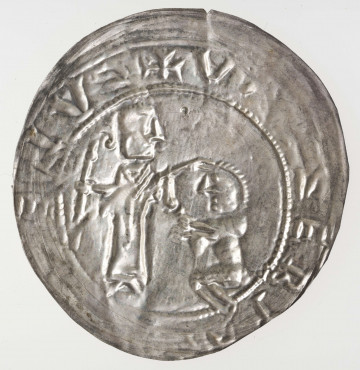Saint Ambrose
1922
National Museum in Lublin
Part of the collection: Money on Polish territory in the Middle Ages
The times of the Kraków Prince Bolesław the Chaste (1243-1279) saw the culmination of the political fragmentation of the Polish lands and the collapse of the idea of the sovereignty of the Senior Prince ruling over Lesser Poland. As a result, the growing Piast dynasty gained powers of central government, including the right to issue currency, which were transferred to the regional princes.
From the long reign of Bolesław the Chaste we know only a few types of coins, distinguished by different images. Apart from the denarius stamped with a pair of obverse and reverse stamps, these are coins produced with a single piston on a very thin sheet (Latin bractea – thin sheet), hence called brakteates. The theme of the two issues – the denarius and the bracteate – is the figure of the Bishop of Kraków, St Stanisław († 1079), accused of treason and killed by King Bolesław the Bold (1058-1079). On the double-sided denarius the legend of St Stanisław is recalled, which tells of the miraculous reunion of his dismembered body and the resurrection of Piotrawin. The composition of the brakteat discussed here is less complex. On it we can see the bust of the bishop with a pastoral and a cross in his hands, surrounded by an inscription – DVX BOLEZL – with the name of the issuer. Interestingly, a variant of this coin is also known with small, crowned heads placed in the space around the inscription. These are probably representations of the princely couple – Bolesław and Jadwiga.
The coins of Bolesław the Chaste are among the oldest testimonies of the cult of the martyred bishop developing from the end of the 12th century, crowned with his canonisation in 1253. It is presumed that they were created shortly after that, possibly in 1254. The elevation of St. Stanislaus to the altar was the effect of the endeavours made at the Holy See by the bishops of Kraków and the circles of princely power. The Saint Bishop as the patron of Poland added prestige to the Kraków cathedral and the power of the prince of Kraków.
Brakteat denars, despite their small size and weight, were not as insignificant a monetary unit as it might seem. In the middle of the 13th century two such coins were enough to cover the daily cost of feeding a man.
Tomasz Markiewicz
Author / creator
Dimensions
cały obiekt:
Object type
numismatic
Technique
stamp minting
Material
silver
Creation time / dating
Creation / finding place
Owner
The National Museum in Lublin
Identification number
Location / status
1922
National Museum in Lublin
1801 — 1900
National Museum in Lublin

1135
National Museum in Lublin
DISCOVER this TOPIC
National Museum in Szczecin
DISCOVER this PATH
Educational path